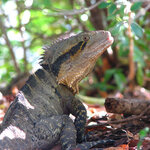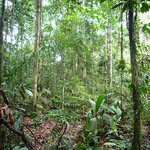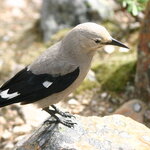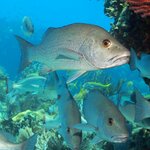Ecology & Zoology

Not every human can be a great leader but not everyone is made to follow either. This has been shown to apply to elsewhere in the animal kingdom as well: insect larvae follow a leader to forage for food, both leaders and followers benefit, growing much faster than if they are in a group of only leaders or only followers, according to a new study.
The research looked at larvae of the iconic Australian steel-blue sawfly Perga affinis often known as 'spitfires'. Sawfly larvae can grow to 7 centimeters long and forage nocturnally in Australian Eucalyptus trees, forming large groups that can strip…

No, it's nothing to do with a reptilian existential crisis – just a name game. Credit: melanie cook/Flickr, CC BY-NC-SA
By Dustin Welbourne
You have likely been to a zoo at some point and visited their reptile house.
A building where the climate control dial is stuck on the “wet sauna” setting, and filled with maniacal children competing to be the first to press their ice cream covered face and hands on every available piece of clean glass.
Assuming you managed to find some clean glass, and supposing the animals were not hiding from the incessant banging and requests to perform like circus…

Why is biodiversity is higher in the tropics than in colder regions? It's one of ecology’s unsolved puzzles and has been since the European explorers and naturalists of the 17th and 18th centuries discovered there is a stunningly rich biodiversity in the tropics compared to the temperate regions of the world.
A research effort led by University of Arizona ecologists has now unearthed unexpected answers and helped found a new discipline, they call it functional biogeography, in the process.
While the sheer number of species that live in rainforests and other tropical habitats is larger than…

Credit: Wing-Chi Poon, CC BY-SA
By Sana Suri, University of Oxford
The 2014 Nobel Prize for Physiology and Medicine was awarded to three neuroscientists for their pioneering work on the brain’s “inner GPS system”. Over the course of four decades, they revealed that a small part in the brain called the hippocampus stores a map of animals' surroundings and helps them navigate.
The award-winning work was done in mice, but it has been shown to be true in other animals too. Seed-caching birds and brood-parasitic cowbirds are two of the most remarkable examples that rely on spatial navigation for…

A research team has discovered that a snail long confused with a far more common snail is actually distinct - and so they named it Aegista diversifamilia. 'Diverse family' being in honor of the modern gay marriage movement, the authors say.
Aegista subchinensis of Taiwan was first described in 1884. In 2003, one of the co-authors Dr. Yen-Chang Lee noticed that there was morphological divergence between the western and eastern populations of A. subchinensis, separated by the Central Mountain Range, a major biogeographic barrier in Taiwan. Lee suggested that there might be cryptic species…

Credit: Ed Bierman, CC BY
By Clive Trueman, University of Southampton
Fish are acutely aware of sea temperature; it’s one of the key reasons particular species of fish live where they do.
As the oceans warm however, many tropical species are moving towards cooler climes. So might the traditional cod and chips one day be replaced by Nemo and chips?
It’s a big question, as the distribution of species across the Earth is one of the most fundamental patterns in ecology. All plants and animals are of course adapted to a limited set of climatic and environmental conditions; if the climate changes…

What could the natural diversity and beauty of plant leaves have in common with the violin, one of mankind's greatest musical inventions? More than you think.
Dan Chitwood, Ph.D., assistant member, Donald Danforth Plant Science Center in St. Louis, Missouri
spends most of his time exploring genetic and molecular mechanisms underlying diversity in plant morphology - how leaf shapes are formed and what that means for a plant to grow and thrive. He also studies how leaf shapes change as plant species evolve to adapt in different environments. Research into why a desert-adapted tomato species…

In last month’s review of Preparing the Ghost, I mentioned that you can actually learn facts from some fiction. Below is one such novel, crammed with science. As author Ryan Lockwood wrote in an e-mail, “Hopefully,
most of the biology described in the book is in-line with real-world
scientific data. I want to educate readers to some extent and
encourage them to learn more after they finish the book.”
Why yes, I AM a huge nerd. Lucky for you, most of those notes didn’t make it into this essay.
Below is a ocean
thriller, along the lines of Jaws. (Beast would be a
better comparison, but…

You're not getting any pudding. Credit: Steve Parsons/PA
By Robert Young, University of Salford
I run 50 kilometers per week on my treadmill and eat a calorie-restricted diet; this is something our ancestors didn’t have to do. But then they didn’t sit at a desk all day and certainly did not have access to such energy rich food.
Unfortunately our animals have joined us on the couch. Take a walk down the pet food aisle in the supermarket and you may be surprised to see rows of diet cat and dog food.
In the US more than 50% of cats and dogs are obese or overweight, just 10% less than the human…

Researchers recently used audio and video recording tools to record larval orientation behavior in the pelagic environment.
In their field experiment, the scientists put the recording devices i a drifting in situ chamber called DISC near Fowey Rocks lighthouse in the northern Florida Keys. In total 58 deployments were conducted, 27 during the day and 31 at night. The team also recorded sounds in a laboratory setting to confirm that the sounds observed in the field were from gray snapper larvae. The researchers also referred to the public sound archive at the Macaulay Library…